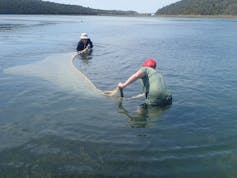![The estuarine pipefish is not easy to find - it camouflages itself amid seagrass. [Picture credit: Louw Claassens]](/media/rhodesuniversity/content/rhodesnews/newsimage/pipefishWeb.webp)
By , PhD candidate, Curtin University and , Research Associate of Zoology and Entomology, Rhodes University
Keeping track of the world’s wildlife populations is fundamental to conservation efforts in the face of the continued deterioration of global biodiversity.
But some species are harder to study than others. Some aquatic species, for instance, elude detection because they are extremely rare and sparsely distributed.
One especially elusive example is the estuarine pipefish (Syngnathus watermeyeri). It is the only critically endangered syngnathid (the family of fishes that includes seahorses, pipefishes and seadragons) in the world. It is only found on the African continent and is endemic to just a few estuaries on the Eastern Cape of South Africa.
It has long been apparent that the estuarine pipefish is threatened. The species was classified as extinct in 1994 before being rediscovered in 1996. There are an estimated 100-250 remaining globally, but not much more is known.
The biggest challenge is keeping count. Population survey methods that work for other species – such as netting, counting and tagging – are simply not as effective for the elusive S. watermeyeri. They are just too small: adults reach between 10cm and 15cm and they are experts at camouflaging amid seagrass to avoid detection.
New technologies may solve the problem. One is environmental DNA (or eDNA). This refers to genetic material derived from organisms – skin cells, blood, faeces and so on – that can be extracted from environmental samples such as water, soil, ice or air. Since it degrades within days or weeks in aquatic environments, eDNA can provide an up-to-date snapshot of the biodiversity within a region. Analysing this material can reveal the presence of rare species that may have otherwise remained hidden.
Our recent study set out to determine whether eDNA is a good tool for monitoring estuarine pipefish. The answer is a resounding “yes”. It is far more successful at detection than the conventional method of seine netting.
We argue that eDNA holds great value as a complementary approach or a method for investigating species’ presence in a particular environment.
Our research was about testing eDNA as a monitoring method, not about updating the estimates on pipefish. But it will help identify priority areas for their conservation, and which habitat characteristics are important for supporting this species.
This knowledge represents a crucial first step to establishing a long-term monitoring and recovery plan for the estuarine pipefish. Now that we know where it is and what habitat it needs, we can identify possible locations to reintroduce the species and then use eDNA to monitor the success of these programmes.
The search
In the spring of 2019, we set out to look for the pipefish and test the use of eDNA as a monitoring tool for this rare species. We conducted seine netting surveys simultaneously to compare the sensitivity of both methods for estuarine pipefish detection.
We sampled all estuaries in South Africa’s Eastern Cape province where the species had been recorded historically: the Kariega, Bushmans, Kasouga, and East and West Kleinemonde estuaries. A total of 39 sites were visited across these five estuaries. At each site, water samples were collected for eDNA, and seine net sweeps were carried out.
It proved to be a laborious task to sweep the seine net through thick beds of seagrass and seaweed while sinking into the muddy estuary banks, but the method was successful. With this method alone, the estuarine pipefish was found at five sites – four within the Bushmans Estuary and one site in the Kariega Estuary.

We didn’t immediately know what the water samples would reveal – they had to be processed. The samples were filtered shortly after collection and taken to the TrEnD laboratory at Curtin University in Perth, Western Australia, which has been specially set up for trace and environmental DNA work like this.
A species-specific assay developed for this study was used to detect the estuarine pipefish in our samples. Following extensive laboratory work and data analysis, this approach proved to be a success: we successfully detected S. watermeyeri using eDNA at 20 out of 30 sites within the Kariega and Bushmans estuaries.
Some populations already lost
Our eDNA findings held some bad news about the estuarine pipefish. The study reinforced several others that have suggested S. watermeyeri is extinct at the Kasouga and East and West Kleinemonde estuaries. This highlights the importance of conserving the Kariega and Bushmans estuaries as a sanctuary for the Critically Endangered syngnathid.
We also confirmed a detail noted in previous surveys: the pipefish is far more likely to be found where there are dense beds of Zostera capensis (a seagrass endemic to southern African estuaries). And we identified Codium seaweed, which formed large free-floating beds among the Zostera seagrass, as an important pipefish habitat.
These findings point to the delicate ecosystems in estuaries – coastal waterbodies found where rivers meet the sea. It underscores how estuaries provide crucial habitats for plants and creatures. Unfortunately, estuaries are under great pressure, particularly from pollution.
This research now means that scientists have a much better picture of the estuarine pipefish’s status. This provides a foundation for developing a long-term monitoring programme for the species. It also exemplifies how new technologies, like eDNA, will be the key to guiding the conservation of the world’s biodiversity.
Original article: https://theconversation.com/dna-in-the-water-shows-south-african-scientists-where-to-find-a-rare-pipefish-193229
